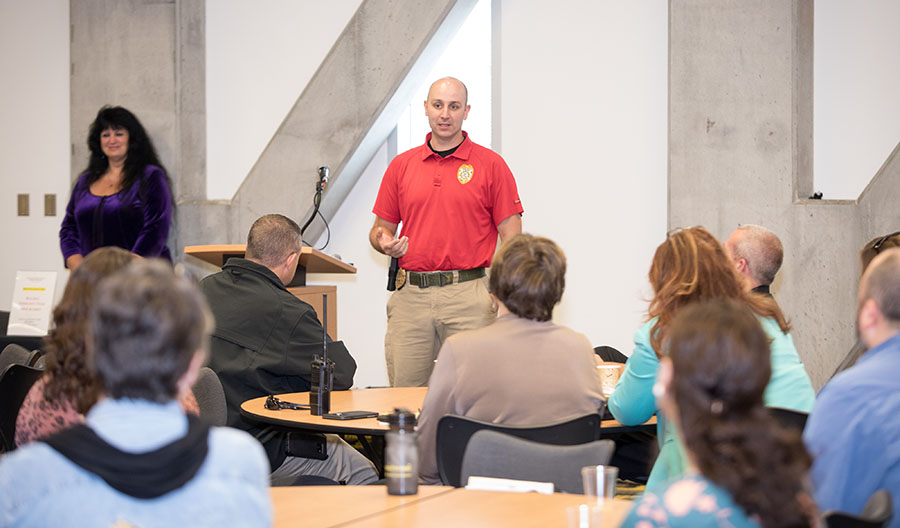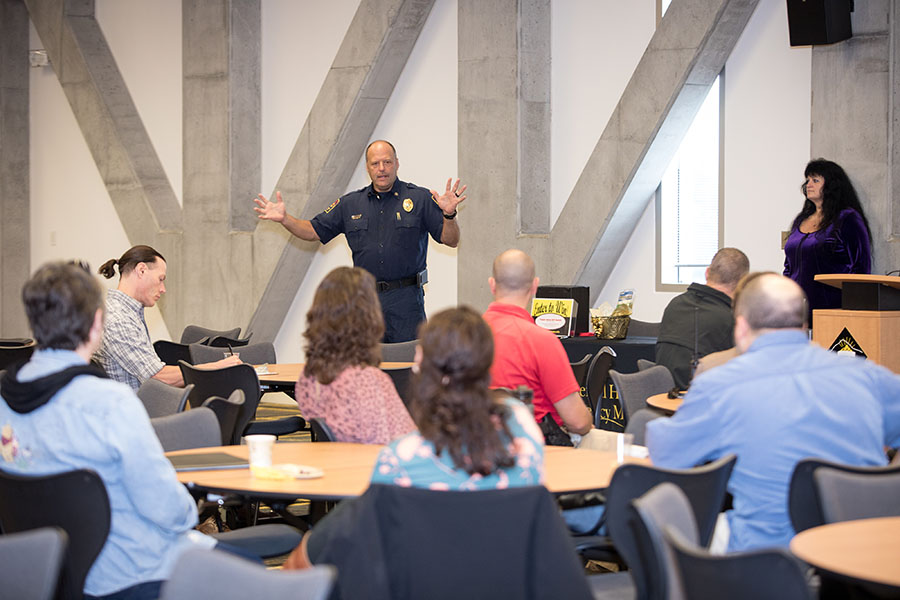BOONE, N.C.—Building Emergency Team members from nine facilities on the Appalachian State University campus met with first responders from University Police and the Boone Fire Department on Thursday, Sept. 7, in the Parkway Ballroom of Plemmons Student Union.
The purpose of the meeting was two-fold: to provide an opportunity for campus emergency team members and first responders to get to know one another, and to offer the chance for safety leaders in the community to provide information that would be useful to everyone in attendance in the case of an emergency.
Debi Trivette, emergency planner with Appalachian’s Environmental Health, Safety and Emergency Management (EHSEM) department, opened the meeting. Trivette is coordinator of the Building Emergency Teams on campus, which consist of representatives from each department within a building. Trivette welcomed and thanked the responders and team members for their attendance and their participation in the Building Emergency Team program.
Jason Marshburn, EHSEM director, followed Trivette with expressions of gratitude and praise for the first responders and Building Emergency Team members. “I am very excited that you are engaged and involved in efforts to ensure building safety on campus,” Marshburn said. He then highlighted some of the safety preparedness efforts on campus, such as, the large-scale emergency exercise that took place last May. The exercise consisted of a mock active shooter event and included participation by various departments on the Appalachian campus, including University Police. Also participating were Boone Fire Department, Watauga County Rescue Squad and Watauga Medical Center. The exercise allowed departments to evaluate their responses and to plan for any future emergencies. Marshburn said that another exercise will take place on campus this fall, which will focus on after-event recovery.
Mike Teague, assistant chief of Boone Fire Department, spoke to the group. He emphasized the need for everyone in a building to participate in emergency drills, even if some individuals are not immediately affected.
“Drills test different components; they may not directly affect everyone, but participation by all persons in a building will help us to become aware of issues and improve in case something happens,” he said. Teague spoke about two recent chemical spills in buildings on campus and used this opportunity to encourage Emergency Building Teams to identify what chemicals are stored in their buildings, where and how much. If an emergency were to occur, fire department staff could find out from team members where the chemicals are, their quantity and be aware of any danger due to a potential toxic mix of chemicals.
Capt. Johnny Brown of University Police asked team members to encourage persons in their departments to contact the police immediately if they see any suspicious object or person on campus.
“Do not wait. Time is critically important,” Brown said. He also encouraged people to share with University Police what they think the department can do to improve.
Adam Jones, who serves as building coordinator for Belk Library and Information Commons, spoke about a small fire that took place in the library in March. Due to the quick action of the library staff, over 100 people were evacuated from all floors in the library in nine minutes.
If there is an emergency, Trivette advised team members to evacuate their buildings quickly and to tell evacuees to go to their identified evacuation assembly area, which is away from the building and out of driveways on which emergency vehicles would arrive.
The new chief of University Police, Andy Stephenson, introduced himself to the responders and building team members. He also thanked everyone for being part of the safety team on campus. “Safety is the most important thing,” he said. “If you do not protect the community, students can’t learn, faculty can’t teach and staff cannot do their jobs.”
What do you think?
Share your feedback on this story.













